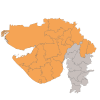Effect of enhanced detailing and mass media on community use of oral rehydration salts and zinc during a scale-up program in Gujarat and Uttar Pradesh
- PMID: 30546870
- PMCID: PMC6287208
- DOI: 10.7189/jogh.09.010501
Effect of enhanced detailing and mass media on community use of oral rehydration salts and zinc during a scale-up program in Gujarat and Uttar Pradesh
Abstract
Background: The Clinton Health Access Initiative implemented a program from 2012-2016 to increase use of oral rehydration salts (ORS) and zinc to treat diarrhea in children under five in three states in India: Gujarat, Madhya Pradesh, and Uttar Pradesh. The program interventions included detailing and development of a rural supply chain to reach private rural health care providers, training of Accredited Social Health Activists (ASHAs), technical support to the state governments, and a mass media campaign targeted at caregivers. In Gujarat and Uttar Pradesh, some of the program activities, such as detailing and ASHA trainings, were targeted to high-burden focal districts, thus providing an opportunity to study their effect compared to statewide activities that covered all districts, such as the mass media campaign. Our study aimed to estimate the effect of activities on ORS and zinc use.
Methods: Household surveys were conducted at two points during the program and in both focal and non-focal districts. We used a difference-in-difference quasi-experimental approach to estimate the effect of the enhanced activities in focal districts and mass media campaign on the odds of a child being treated with ORS and zinc.
Findings: Focal district interventions were associated with a significant increase in the odds of a diarrhea episode receiving ORS in Gujarat and Uttar Pradesh. Living in focal districts increased the odds of receiving ORS in Gujarat and Uttar Pradesh by factors of 3.42 (95% CI = 1.39-8.33) and 2.29 (95% CI = 1.19-4.39), respectively. Focal district interventions were also associated with 15.02 (95% CI = 2.97-75.19) greater odds of receiving both ORS and zinc in Gujarat. In Uttar Pradesh, where the mass media campaign was focused, exposure to the campaign further modified the odds of receiving ORS and combined ORS and zinc by 1.38 (95% CI = 1.04-1.84) and 1.57 (95% CI = 1.01-2.46), respectively.
Conclusion: Comprehensive public and private provider interventions combined with mass media are effective strategies for increasing ORS and zinc use.
Conflict of interest statement
Competing interests: SA, NB, FL, MRP, KS, MS, VS, AT, AM, HS, NT, and LW were employed by the Clinton Health Access Initiative and received funding to design, implement, and evaluate the program addressed in this manuscript to scale up the use of ORS and zinc. GP received fees from the Clinton Health Access Initiative to support data analysis. The authors have completed the Unified Competing Interest form at www.icmje.org/coi_disclosure.pdf (available on request from the corresponding author) and declare no other conflicts of interest.
Figures
Similar articles
-
An external evaluation of the Diarrhea Alleviation through Zinc and ORS Treatment (DAZT) program in Gujarat and Uttar Pradesh, India.J Glob Health. 2015 Dec;5(2):020409. doi: 10.7189/jogh.05.020409. J Glob Health. 2015. PMID: 26682045 Free PMC article.
-
The Association between Provider Practice and Knowledge of ORS and Zinc Supplementation for the Treatment of Childhood Diarrhea in Bihar, Gujarat and Uttar Pradesh, India: A Multi-Site Cross-Sectional Study.PLoS One. 2015 Jun 22;10(6):e0130845. doi: 10.1371/journal.pone.0130845. eCollection 2015. PLoS One. 2015. PMID: 26098305 Free PMC article.
-
Scaling-up public sector childhood diarrhea management program: Lessons from Indian states of Gujarat, Uttar Pradesh and Bihar.J Glob Health. 2015 Dec;5(2):020414. doi: 10.7189/jogh.05.020414. J Glob Health. 2015. PMID: 26682047 Free PMC article.
-
Review on development and community implementation of oral rehydration therapy.Indian J Public Health. 1994 Apr-Jun;38(2):50-7. Indian J Public Health. 1994. PMID: 7835996 Review.
-
Measuring coverage in MNCH: current indicators for measuring coverage of diarrhea treatment interventions and opportunities for improvement.PLoS Med. 2013;10(5):e1001385. doi: 10.1371/journal.pmed.1001385. Epub 2013 May 7. PLoS Med. 2013. PMID: 23667330 Free PMC article. Review.
Cited by
-
Barriers and facilitators to implementation of oral rehydration therapy in low- and middle-income countries: A systematic review.PLoS One. 2021 Apr 22;16(4):e0249638. doi: 10.1371/journal.pone.0249638. eCollection 2021. PLoS One. 2021. PMID: 33886584 Free PMC article.
-
Stakeholder engagement in healthcare research in India - A systematic review.Health Res Policy Syst. 2025 May 15;23(1):57. doi: 10.1186/s12961-025-01341-9. Health Res Policy Syst. 2025. PMID: 40375276 Free PMC article. Review.
-
Childhood diarrhoea in southwestern Nigeria: Predictors of low osmolarity ORS and zinc use among mothers.J Taibah Univ Med Sci. 2022 May 27;17(6):1006-1013. doi: 10.1016/j.jtumed.2022.05.003. eCollection 2022 Dec. J Taibah Univ Med Sci. 2022. PMID: 36212577 Free PMC article.
-
Factors associated with zinc utilization for the management of diarrhea in under-five children in Ethiopia.BMC Public Health. 2020 Sep 24;20(1):1447. doi: 10.1186/s12889-020-09541-4. BMC Public Health. 2020. PMID: 32972377 Free PMC article.
-
The Co-Utilization of Oral Rehydration Solution and Zinc for Treating Diarrhea and Its Associated Factors Among Under-Five Children in Ethiopia: Further Analysis of EDHS 2016.Patient Prefer Adherence. 2022 Jul 21;16:1713-1721. doi: 10.2147/PPA.S356557. eCollection 2022. Patient Prefer Adherence. 2022. PMID: 35903082 Free PMC article.
References
-
- World Health Organization & UNICEF. Joint Statement on the Clinical Management of Acute Diarrhoea. 2004.
-
- International Institute for Population Sciences (IIPS). Macro International. National Family Health Survey (NFHS-3), 2005-06: India. Mumbai: IIPS, 2007.
-
- Tyagi BN. A review of diarrhoeal disease control programme in India. Health Popul Perspect Issues. 1983;6:209–25.
Publication types
MeSH terms
Substances
Grants and funding
LinkOut - more resources
Full Text Sources
Medical




